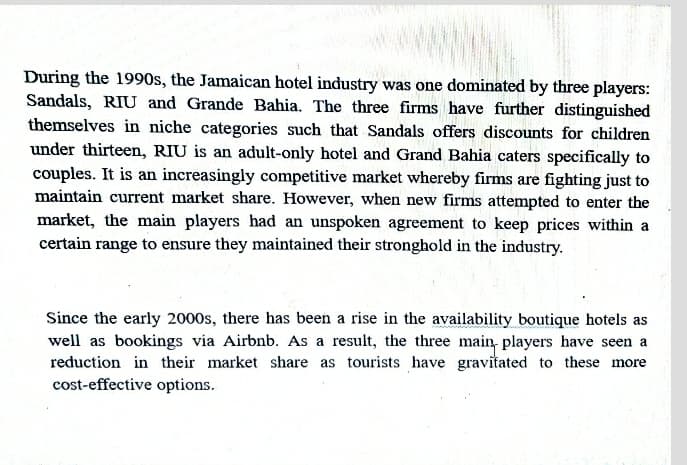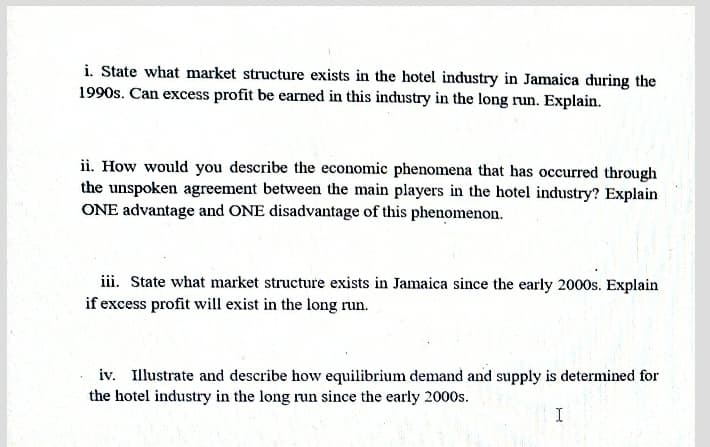During the 1990s, the Jamaican hotel industry was one dominated by three players: Sandals, RIU and Grande Bahia. The three firms have further distinguished themselves in niche categories such that Sandals offers discounts for children under thirteen, RIU is an adult-only hotel and Grand Bahia caters specifically to couples. It is an increasingly competitive market whereby firms are fighting just to maintain current market share. However, when new firms attempted to enter the market, the main players had an unspoken agreement to keep prices within a certain range to ensure they maintained their stronghold in the industry. Since the early 2000s, there has been a rise in the availability boutique hotels as well as bookings via Airbnb. As a result, the three main, players have seen a reduction in their market share as tourists have gravitated to these more cost-effective options.
During the 1990s, the Jamaican hotel industry was one dominated by three players: Sandals, RIU and Grande Bahia. The three firms have further distinguished themselves in niche categories such that Sandals offers discounts for children under thirteen, RIU is an adult-only hotel and Grand Bahia caters specifically to couples. It is an increasingly competitive market whereby firms are fighting just to maintain current market share. However, when new firms attempted to enter the market, the main players had an unspoken agreement to keep prices within a certain range to ensure they maintained their stronghold in the industry. Since the early 2000s, there has been a rise in the availability boutique hotels as well as bookings via Airbnb. As a result, the three main, players have seen a reduction in their market share as tourists have gravitated to these more cost-effective options.
Principles of Microeconomics (MindTap Course List)
8th Edition
ISBN:9781305971493
Author:N. Gregory Mankiw
Publisher:N. Gregory Mankiw
Chapter17: Oligopoly
Section: Chapter Questions
Problem 9PA
Related questions
Question
100%
Hi please answer i and ii

Transcribed Image Text:During the 1990s, the Jamaican hotel industry was one dominated by three players:
Sandals, RIU and Grande Bahia. The three firms have further distinguished
themselves in niche categories such that Sandals offers discounts for children
under thirteen, RIU is an adult-only hotel and Grand Bahia caters specifically to
couples. It is an increasingly competitive market whereby firms are fighting just to
maintain current market share. However, when new firms attempted to enter the
market, the main players had an unspoken agreement to keep prices within a
certain range to ensure they maintained their stronghold in the industry.
Since the early 2000s, there has been a rise in the availability boutique hotels as
well as bookings via Airbnb. As a result, the three main, players have seen a
reduction in their market share as tourists have gravitated to these more
cost-effective options.

Transcribed Image Text:i. State what market structure exists in the hotel industry in Jamaica during the
1990s. Can excess profit be earned in this industry in the long run. Explain.
ii. How would you describe the economic phenomena that has occurred through
the unspoken agreement between the main players in the hotel industry? Explain
ONE advantage and ONE disadvantage of this phenomenon.
iii. State what market structure exists in Jamaica since the early 2000s. Explain
if excess profit will exist in the long run.
iv. Illustrate and describe how equilibrium demand and supply is determined for
the hotel industry in the long run since the early 2000s.
I
Expert Solution
This question has been solved!
Explore an expertly crafted, step-by-step solution for a thorough understanding of key concepts.
Step by step
Solved in 2 steps

Knowledge Booster
Learn more about
Need a deep-dive on the concept behind this application? Look no further. Learn more about this topic, economics and related others by exploring similar questions and additional content below.Recommended textbooks for you

Principles of Microeconomics (MindTap Course List)
Economics
ISBN:
9781305971493
Author:
N. Gregory Mankiw
Publisher:
Cengage Learning

Exploring Economics
Economics
ISBN:
9781544336329
Author:
Robert L. Sexton
Publisher:
SAGE Publications, Inc

Principles of Economics 2e
Economics
ISBN:
9781947172364
Author:
Steven A. Greenlaw; David Shapiro
Publisher:
OpenStax

Principles of Microeconomics (MindTap Course List)
Economics
ISBN:
9781305971493
Author:
N. Gregory Mankiw
Publisher:
Cengage Learning

Exploring Economics
Economics
ISBN:
9781544336329
Author:
Robert L. Sexton
Publisher:
SAGE Publications, Inc

Principles of Economics 2e
Economics
ISBN:
9781947172364
Author:
Steven A. Greenlaw; David Shapiro
Publisher:
OpenStax

Managerial Economics: A Problem Solving Approach
Economics
ISBN:
9781337106665
Author:
Luke M. Froeb, Brian T. McCann, Michael R. Ward, Mike Shor
Publisher:
Cengage Learning


Principles of Economics, 7th Edition (MindTap Cou…
Economics
ISBN:
9781285165875
Author:
N. Gregory Mankiw
Publisher:
Cengage Learning